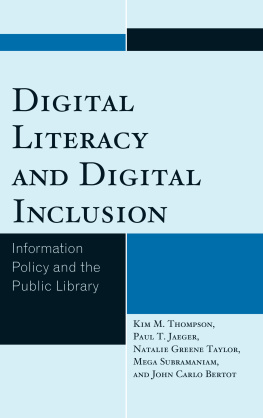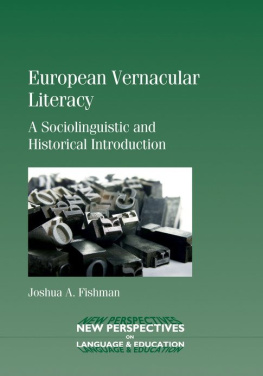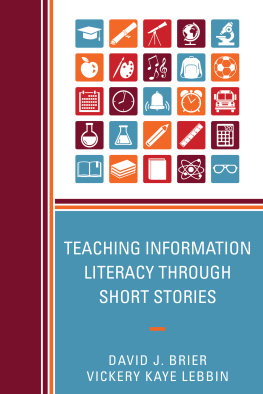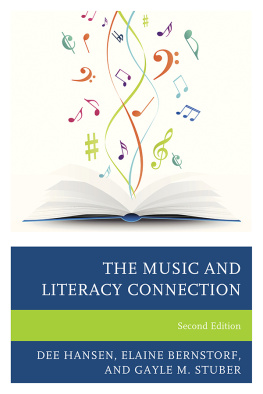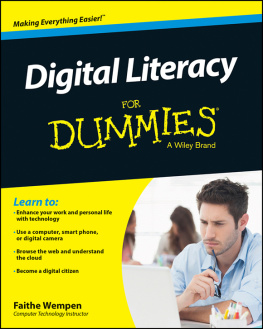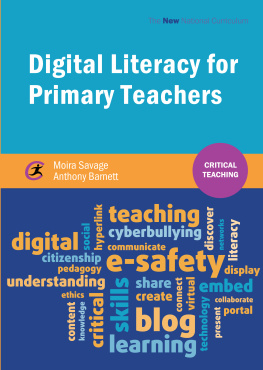DIGITAL VISUAL LITERACY
The Librarians Quick Guide
Nicole M. Fox

Copyright 2022 by Nicole M. Fox
All rights reserved. No part of this publication may be reproduced, stored in a retrieval system, or transmitted, in any form or by any means, electronic, mechanical, photocopying, recording, or otherwise, except for the inclusion of brief quotations in a review, without prior permission in writing from the publisher.
Library of Congress Cataloging-in-Publication Data
Names: Fox, Nicole M., author.
Title: Digital visual literacy : the librarians quick guide / Nicole M. Fox.
Description: Santa Barbara, California : Libraries Unlimited, 2022. | Includes bibliographical references and index.
Identifiers: LCCN 2021055615 (print) | LCCN 2021055616 (ebook) | ISBN 9781440875175 (paperback) | ISBN 9781440875182 (ebook)
Subjects: LCSH: Visual literacy. | Computer literacy. | Digital humanities.
Classification: LCC LB1068 .F68 2022 (print) | LCC LB1068 (ebook) | DDC 371.33/5dc23/eng/20211213
LC record available at https://lccn.loc.gov/2021055615
LC ebook record available at https://lccn.loc.gov/2021055616
ISBN:978-1-4408-7517-5 (paperback)
978-1-4408-7518-2 (ebook)
262524232212345
This book is also available as an eBook.
Libraries Unlimited
An Imprint of ABC-CLIO, LLC
ABC-CLIO, LLC
147 Castilian Drive
Santa Barbara, California 93117
www.abc-clio.com
This book is printed on acid-free paper 
Manufactured in the United States of America
To my wonderful husband, Santhanai, for always believing in me. Youre the best!
And to Claire and Jenny, the best instruction librarians Ive ever met! Thank you for supporting and guiding me as a librarian.
Contents
What Is Visual Literacy?
As librarians, we get the pleasure of working with and sharing a variety of different information sources, from traditional books and articles to preserved ephemera in special collections. Libraries have been quick to adapt over the years, embracing new forms of born-digital information. However, much like in other areas in academia, there remains a reluctance to see images for what they really are: not just decorative art, but valuable sources of information. Today, the vast majority of images we encounter on a daily basis have touched the internet in one form or another, whether they were created digitally through the use of tools like Photoshop, digitized and stored in a librarys online repository, or shared on social media. People say that a picture is worth a thousand wordsbut images are much more than the many thousands of words you could use in their description. Its perhaps better to measure a picture by the forms, elements, contexts, and meanings that make up each one of the images we encounter on a daily basis.
This book is designed to be a quick, informative guide to visual literacy instruction in any classroom, not just the art or design classroom. In order to connect visual literacy instruction to the digital space it now occupies, this book also features several workshops and instruction sessions that use digital humanities tools. Maybe youve struggled with finding an innovative way to keep your students engaged in an image copyright one-shot lesson or you need to find a great image evaluation workshop suitable for use in an online course; either way, this book should serve as a useful resource in your instruction planning.
INTRODUCTION TO DIGITAL VISUAL LITERACY
Whenever I talk to a fellow librarian about visual literacy, the most common question I get is: What exactly is visual literacy, anyways? How does it differ from information literacy? While visual literacy has become somewhat of a buzzword, its not a major part of MLS curriculums, and it remains jargon to most teaching librarians outside of the artsmuch less to students.
Understanding Visual Literacy
Simply put, visual literacy is the ability to construct meaning from images..
We can derive meaning from it just by giving it a cursory glance. From a basic examination of this image, we can tell its a picture of a barren, rocky landscape with a dark sky. The picture itself is not entirely impressive. Theres nothing colorful, unexpected, or interesting that catches the viewers eye, and its grainy and marred with lighter stripes.

PHOTO 1.1.Close-Up of Crater Copernicus. November 23, 1966, National Aeronautics and Space Administration.
Source: NASA.
But theres more that gives an image meaning than just the actual picture itself. Take a look at the image caption. The title, date, and credit add valuable context to this picture. This isnt just a picture of a desolate landscape, its a photo taken on the moon . This context transforms this image from bland to something quite extraordinary. The landscape somehow becomes even more barren, now that we know theres no life hidden among the rocks and ridges in the picture. Though its grainy compared to the high-resolution images were accustomed to, it marks the very height of technological advances during the time in which it was taken. Its easy enough to derive meaning from images, but visual literacy as a concept is more focused on navigating the many different layers of meaning that are attached to each image.
Lets look again at our moon photo. If this photo were being used to illustrate a narrative describing the moon, the viewer would need to decipher why this photo, over the millions of other photos of the moon, was selected. Usually pictures emphasize the narratives they illustrate; theyre a conscious choice made by a creator. If this photo accompanied an article that described the moon as totally unsuitable for any future colonization efforts a country might attempt, this photo would echo and amplify those ideas. The moon here appears bleak and unfriendly, and the photo emphasizes the idea that its an unsuitable landscape for human life. This is due, in part, to the use of artistic principles in the image. In our example, the use of color makes this photo appear lifeless and almost forebodingthe landscape is mostly dark, and the sky above the crater is an endless black, unbroken by any celestial objects. If a writer wanted to say the oppositethat is, that with the right tools a colony could flourish on the moon, they would certainly not select this image to accompany their article. A photo such as the famous Earthrise from NASA could be a better choice. With our planet rising in the lunar sky, this image makes the moon feel not quite so far from home. Though the sky is just as dark, there are also a lot of lighter colors in this image, which ultimately serves to emphasize the lighter lunar surface and the gleaming Earth. Even a photo of a full moon hanging in the night sky as a source of light in the middle of the night would look more inviting and optimistic. This intent in image selection is yet another meaning-layer that can be interpreted from visual materials, and any visually literate viewer should try to determine what kind of story the image is trying to tell the viewer.
The visually literate individual doesnt just investigate what an image depicts or why an image is used, however, particularly when using images for their projects. Knowing the copyright and other ethical considerations is yet another type of meaning-layer that needs to be navigated when using images. Though its easy to find images, not everyone gives credit for the images they use in their assignments, nor does everyone know what images can be used for what purpose. Much like how an information literate writer knows how to cite the works they use, the same must be done for any images that the user hasnt personally created. There are many types of licenses and policies that can also affect an images ability to be used for a project. Understanding the public domain, fair use, and Creative Commons licenses will give students and other users the freedom to use and create different kinds of image-rich projects, as well as share them with the world. Close-Up of Crater Copernicus , our first example image, is in the public domain and is available through the Metropolitan Museum of Arts Open Access Policy, and the title, date, and organization are cited in the images caption. The visually literate viewer could take that caption information and not just use it to provide context about the image; they could use it to find out more about where the image was originally found.
Next page

